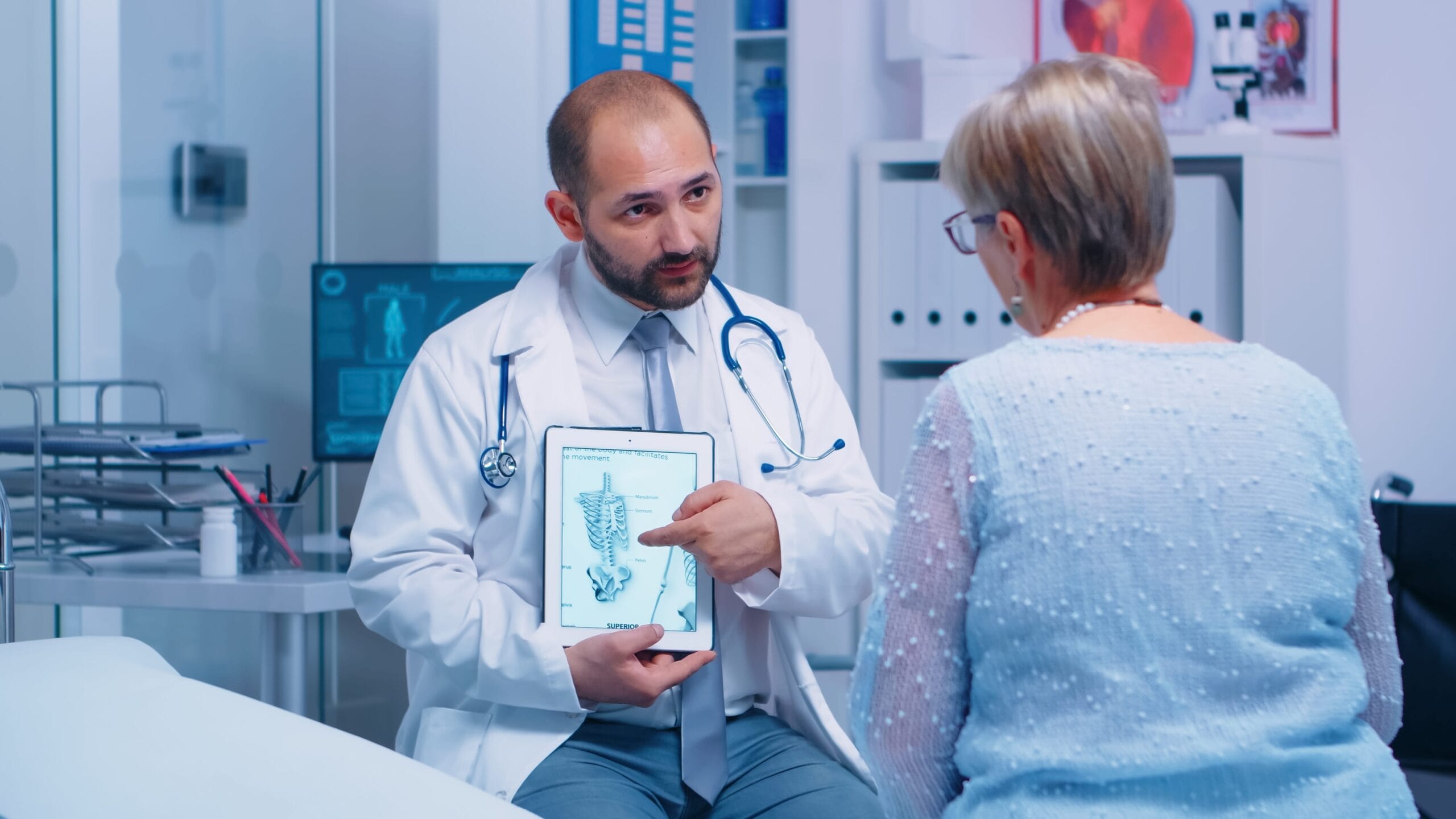Preventing Osteoporosis — 6 Tips and Lifestyle Tricks

Many know that osteoporosis is a serious medical condition characterized by bone loss and low bone density that is common among older adults. What many people don't know is that there are many ways to help prevent osteoporosis, or at least minimize its severity. That's right: many factors for bone health are within our control!
Keep reading to learn more about how you and your loved ones can take steps to maintain healthy bones as you age.
Risk Factors for Osteoporosis
Before we discuss how to best prevent or mitigate the risk of osteoporosis, we first need to understand what risk factors you can control.
Factors We Cannot Control
Non-controllable factors that can lead to increased risk of osteoporosis and osteopenia (less severe low bone density) include:
- Family history
- Age
- Menopause
- Sex
- Race
- Endocrine disorders
Factors We Can Control
While we cannot control our age or family history, we can mostly control other factors that may put us at risk, such as:
- Alcohol consumption
- Poor diet
- Smoking
- Not getting enough physical exercise
How to Prevent Osteoporosis for At-Risk Individuals
Left untreated, this condition can lead to reduced bone strength, loss of bone mass, and increased risk of pain and bone fractures, especially spinal, wrist, forearm, and hip fractures.
Fortunately, the following actions can help you in your osteoporosis prevention journey.
1. Eat a Healthy Diet
Enjoying a diet full of good foods is a major part of leading a healthy lifestyle. When it comes to keeping bones healthy and strong, it's important to focus on a diet rich in calcium, vitamin D, magnesium, phosphorus, and vitamin K
Calcium
Calcium is what our bodies need not just to make strong bones, but to create new bone tissue that replaces old bone tissue. In other words, without this critical nutrient, our body cannot build bone effectively. That is why it is so important to meet the daily recommended amount of calcium. While the exact amount of calcium each person needs will vary based on factors like age and sex, most adults need around 1000 mg to 1200 mg each day.
Calcium-rich foods include:
- Dairy products like milk, yogurt, and cheese
- Oranges
- Tofu
- Almonds
- Leafy green vegetables like spinach and kale
Vitamin D
Vitamin D helps the body absorb calcium. So, even if you get enough calcium, if you do not get enough vitamin D, your body will not be able to create and maintain healthy bones.
The best way to get vitamin D? (Safe) sun exposure. How much exposure someone needs will vary based on a variety of factors, including skin color, the season, climate, age, and more. When someone doesn't get enough vitamin D from sun exposure, diet can help.
Food rich in vitamin D include:
- Fortified cereals
- Eggs
- Fortified milk
- Fatty fish like salmon
- Tofu
Magnesium
Building strong bones requires lots of nutrients, including magnesium. The daily recommended amount of magnesium is 420 mg for 51+ men and 320 mg for 51+ women. The easiest way to get enough magnesium every day is through diet.
Foods rich in magnesium include:
- Spinach
- Oatmeal
- Bananas
- Pumpkin seeds
- Yogurt
Phosphorus
Phosphorus is yet another important nutrient the body needs to create new bones. The daily recommended amount of phosphorus for adults is 700 mg and, fortunately, phosphorus deficiency is rare in the United States.
The best way to get enough phosphorus? You guessed it—eating the right foods, including:
- Asparagus
- Cashews
- Brown rice
- Lentils
- Eggs
Vitamin K
Vitamin K helps the body maintain good bone health, and some research links lower levels of vitamin K with increased risk of hip fractures, suggesting that vitamin K supplementation could be valuable as a treatment for osteoporosis. The daily recommended amount of vitamin K is 120 mcg for adult men and 90 mcg for adult women.
The easiest way to get this nutrient is through foods like:
- Collard greens
- Kale
- Spinach
- Pumpkin
- Cashews
2. Take Supplements
The best sources of calcium and other nutrients are the foods you eat. But if you're not getting the nutrients you need from your diet alone, it could be time to talk with your medical team about taking supplements, especially calcium and vitamin D supplements.
Do not just go to the store and pick up any supplement, though. It's important to discuss with a medical professional the right kind and dosage of supplements for you or your loved one's specific needs, as getting too much of any vitamin, mineral, or other nutrient can negatively affect bone health as much as getting too little can. Furthermore, some supplements can negatively interact with other over-the-counter medications and even prescription drugs.
Calcium Supplements
Calcium supplementation is common for older adults at risk for osteoporosis. A medical team will likely recommend one of the two most common forms of calcium supplements in the US: calcium carbonate and calcium citrate.
When taking calcium supplements, it's important to keep the following in mind, according to the US Office of Dietary Supplements:
- Consume in doses of 500 mg or less, as the body absorbs this nutrient best in these lower doses
- Take calcium carbonate supplements with food to increase absorption; the body can absorb calcium citrate supplements well either with or without food
- Older adults may more easily absorb calcium citrate supplements that calcium carbonate ones
Vitamin D Supplements
Age, weather, pollution, and other factors can all affect how much vitamin D someone's skin absorbs from sun exposure. Coupled with the fact that there are limited food sources of vitamin D, supplementation is a popular way for many older adults to meet their daily recommended amount of this nutrient.
Like calcium, vitamin D supplements often come in two forms in the US: D2, or ergocalciferol, and D3, or cholecalciferol. The primary difference between the two is, according to the US Office of Dietary Supplements, is that the D3 form is more likely to increase blood levels of vitamin D than the D2 form, and the D3 form may increase blood levels for longer than the D2 form as well.
As a fat-soluble substance, taking vitamin D with food increases absorption.
3. Take Bisphosphonates
Bisphosphonates, or diphosphonates, are a group of drugs that can help reduce the risk of fracture and improve bone mineral density in postmenopausal women, making them a common treatment option for this condition for both men and women alike.
The most common forms of this drug in use in the US are what are known as nitrogen-containing bisphosphonates, or ones that contain nitrogen. They commonly come in the form of:
- Pamidronate (Aredia)
- Alendronate (Fosamax)
- Ibandronate (Boniva, Bonviva)
- Risedronate (Actonel)
- Zoledronate (Reclast, Aclasta)
4. Try Balance, Resistance and Weight-Bearing Exercises
Diet and exercise work in tandem to keep your body in tip-top shape. When selecting exercises to treat or prevent osteoporosis, experts often recommend a combination of the following:
- Balance training, which can reduce the risk of falls in all age groups, but especially older adults. Examples of balance exercises include yoga and tai chi.
- Resistance training, which can strengthen both muscles and bones. Resistance exercises can include using equipment like free weights or resistance bands or even using body weight to complete exercises like push-ups.
- Weight-bearing exercises, which can strengthen bones. Examples of weight-bearing activities include power walking and climbing stairs.
What is most important, however, is that you select physical activities you enjoy, because it means you will stick with them.
5. Limit Alcohol Consumption
Plenty of research links alcohol intake with increased risk of fractures for older adults, especially osteoporotic ones. In addition to increasing the risk of falls and fractures, excess alcohol can also increase the risk of developing weaker, more brittle bones. So, when it comes to osteoporosis prevention and treatment, keeping alcohol consumption to a minimum is ideal.
6. Don't Smoke
The single-most important lifestyle change you can make to not just reduce your risk of osteoporosis, but also to lead a healthier life, is to quit smoking. Evidence shows that long-term tobacco smoking can reduce bone mass and is even linked to plenty of other osteoporosis risk factors like excess alcohol consumption, low BMI, and a sedentary lifestyle. "Smoking" here doesn't just refer to tobacco consumption; it also refers to marijuana consumption as well, as some experts have found that long-term use of cannabis was associated with having lower bone mineral density and an increased risk of fracture, among other osteoporosis risk factors.
Fighting Osteoporosis at St. Andrew's
At St. Andrew's we take the health concerns of our residents seriously. When someone in our community has osteoporosis or is at risk of developing it, we work with them and their medical team to create the most comprehensive treatment or prevention plan possible. That includes our 24/7 caregivers ensuring that our residents always take the medications they need on time, our culinary team catering meals to the dietary needs of each resident, and offering a wide array of exercise and wellness activities to keep residents up and moving.
Disclaimers - This article does not constitute professional medical advice; it cannot diagnose, treat, cure, or prevent any disease or condition. Always consult with a licensed medical professional/healthcare provider before beginning any new exercise programs, diets, or supplement routines.







